HMS DIANTHUS - A Short HistoryBy Michael J Watts |
 |
Lt CDR Bridgman RNR was relieved by Lt CDR Israel RNR on 6th November 1942, the ship becoming operational and returning to Escort Group C.5 again shortly afterward. Almost continuously for the rest of 1942 and most of 1943 DIANTHUS was at sea criss-crossing the Atlantic escorting the slow moving convoys between Liverpool and Halifax or New York and back. Having spent Christmas and New Year in America after escorting one of the last convoys of 1942 across the Atlantic, DIANTHUS prepared for sea and on 12th January convoy SC 117 sailed from New York with twenty-one ships, arriving at Liverpool on 3rd February for no loss.
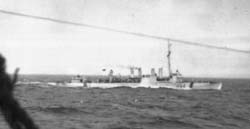 HMS Burwell - one of the 50 ex-American destroyers lent to the RN in exchange for bases |
As the war progressed and anti-submarine warfare methods improved more and more convoys reached their destination unscathed. C.5 escort group didn't have everything its own way though. Convoy ON 166 which sailed from Liverpool on 11th February 1943 with 48 merchantmen and DIANTHUS as one of the escorts, proved that the U-boats, although suffering massive losses, was still a force to be reckoned with. The first attack came on 21st February when the Norwegian ship 'Stigstad' was sunk by U332 and U603. The next day 'Chattanooga City' and 'Empire Redshank' where sunk by U606 as well as 'N T Nielsen Alonso' by U92 and U603. The 23rd was the worst day of all with seven ships being torpedoed and sent to the bottom. 'Empire Trader' by U92, 'Eulima' and 'Hastings' byU186, 'Stockport' by U604, 'Winkler' by U628 and U223, 'Expositor' by U606 and U303, and 'Glittre' by U628 and U603. On the 24th the intensity of the attacks reduced with 'Ingria' being sunk by U600 and U628, and 'Jonathan Sturges' sunk by U653. 'Manchester Merchant'was the final loss of the convoy being sunk on the 25th February. The convoy arrived at New York on 3rd March at a cost of eleven ships and 262 seamen.
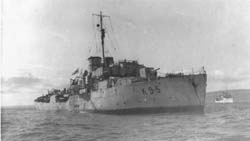 HMS Dianthus after refit. The mast is now behind the bridge. Of interest is the gunshield artwork |
After a maintenance period and a little rest and recuperation DIANTHUS sailed with convoy HX 233 sailed bound for Liverpool on 6th April. Fifty-three arrived, only one ship ëFort Rampartí carrying 1400 tons of metal and 7300 tons of lumber, was sunk by U628 and U226 on the 17th, during the crossing. The convoy arrived at its destination on 21st April.
Convoy ON 182 sailed from Liverpool on the 6th May consisting of fifty-six ships and arrived at New York on the 22nd without loss. When within sight of the Eastern Seaboard DIANTHUS was discharged from this convoy and immediately picked up convoy HX 240 which had sailed from New York on the 19th May. Again it consisted of fifty-six ships and arrived at Liverpool on the 4th June without loss. Convoy ON 188 left Liverpool on 10th June and arrived at New York on the 26th again fifty-six ships for no loss. And so it went on month after month criss crossing the North Atlantic.
During this time she helped in the sinking of another U-boat (identity unknown) with other escorts. After the submarine was observed to be sinking, and in broad daylight, a trigger happy U.S. escort started to machinegun the abandoning crew. DIANTHUS placed herself in harms way between the U.S. ship and the submarine. Unfortunately the Captian and several crew where killed. DIANTHUS was also credited with another submarine kill. After being damaged by depth charges (probably to its ballast tanks) the submarine never re-surfaced. According to reports the sonar operator heard the submarine struggling to reach the surface with both motors at full ahead, but slowly sinking by the stern in a downward spiral until she imploded. The identity of the submarine is unknown as she was lost with all hands. On the 31st August Lt CDR Israel left DIANTHUS and Lt Bowick, the then 1st Lieutenant assumed command.
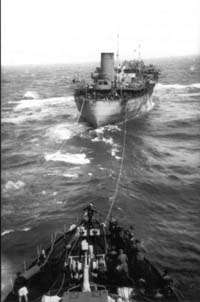 Refueling at sea |
During the first half of 1944 the Allies gained almost total domination of the shipping lanes in the Atlantic, with the U-boats suffering unsustainable losses. Toward the end of April the convoys started to become larger. This released escort ships for other duties DIANTHUS being among them, transferring from C.5 Escort to Portsmouth. She was fitted with more Anti-aircraft guns (possibly at Phillip Hills Shipyard at Bristol), and then sent to Milford Haven. Here a massive convoy began to form, consisting of transport ships of every possible shape and size.
Late on 4th June 1944 DIANTHUS, along with many other escorts, sailed with the convoy, the destination being the invasion beaches of Normandy. DIANTHUS was to be stationed near 'OMAHA Beach' close to the coastal town of Port-en-Bessin arriving at around 1800 on D Day, 6th June. For a day or so British bbattleships and cruisers to seaward pounded the cliffs and dunes with their heavy guns, helping to evict the German troops entrenched in the area.
As the Allied armies advanced inland, and after the rapid construction of the "Mulberry Harbour", DIANTHUS spent the rest of her time escorting convoys up and down The English Channel. This was very dangerous work as the convoys where vulnerable from not only submarine attack, but also from German aircraft and E-Boats. During one such convoy between Dover and Calais, DIANTHUS and her crew witnessed the flight of the very first V1 "Flying bomb" (later nicknamed as the Doodlebug). As it passed overhead the glow from the exhaust could clearly be seen. No one knew what it was so the anti-aircraft gunners where ordered to hold their fire. The facts became known the next day when they were announced over the radio.
During a lull in convoy duties shortly after D-Day and while anchored off Portsmouth in a busy Solent, DIANTHUS almost ran out of food, and had to break into the emergency ships biscuits. The reason was because of the huge amount of ships needing victuals and the vast amount of food and supplies being moved to France had caused a mini famine. The crew treated it as a bit of a joke as they could see Portsmouth and buy 'tuck' and the like from the NAFFI. Also at around this time an American landing craft caught DIANTHUS a glancing blow, rolling her over on her starboard side to about 60°. Luckily there was not much damage, mostly broken crockery and a burst steam pipe.
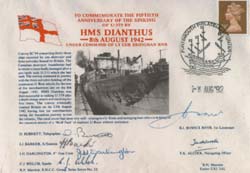 50th Anniversary cover |
DIANTHUS carried out her duties faithfully until the end of the war. She was de-commissioned almost immediately and probably laid up on the River Tamar close to Saltash. Here she remained for about eighteen months until being sold to Norway in May 1947, and renamed 'THORSLEP', beginning a commercial career as a whale-catcher. All attempts to uncover what happened to THORSLEP have proved fruitless.
Lt Cdr Bridgman left DIANTHUS in November 1942. His potential had been recognised so it was not long before he was appointed as commander of a larger ship, joining the River Class Frigate HMS ITCHEN on 27th January 1943. Soon after he was promoted to the rank of Commander. To this there is a sad postscript. On 23rd September 1943 HMS Itchen, while acting as an escort to convoy ONS 18, was struck in a magazine by an acoustic torpedo fired from U666 and sank in a matter of minutes. She was also carrying the rescued crews from HMS Polyanthus and HMS St. Croix, both of which had been sunk during the preceding few days. A total of three men where pulled from the water out of three ships companies. No crew members from HMS ITCHEN survived.
Lt CDR Israel survived the war and after being demobbed returned to the merchant navy re-assuming his rank of captain or master. As fate was to have it he took command of one of the corvettes, which was converted for use as a weather ship. Their job was to patrol the shipping lanes of the North Atlantic and relay weather reports and other information to the Met people.
CONVOY IDENTIFYING CODES
Every convoy was identified by a two or three letter code and number. The list although not exhaustive is quite lengthy. Below are the convoy codes and meanings that would have affected DIANTHUS. HX Halifax (or New York) to the UK. Convoy speeds of no less than 10 knots.
XB Halifax to Boston.
BX Boston to Halifax.
SC Slow Convoy making no more than 7 knots. Halifax (or New York) to the UK.
ONS Slow Convoy making no more than 7 knots. UK to Halifax (or New York) from 1943 onwards.
ON Outward North - Liverpool to North America - convoys making speeds of between 7.5 - 9 knots
FN Forth North - Coastal convoy to the Forth Estuary from the Thames.
FS Forth South -- Coastal convoy from the Forth Estuary to the Thames.
OF THE FLOWER CLASS CORVETTE
A total of 258 Flower Class Corvettes were constructed during the war with 151 built in Britain and a further 107 in Canada. The average build time was around seven months; the fastest build time though was 'Nasturtium' at four months and three days, the slowest 'Pentstemon' taking twenty months and three days. As well as with the RN, the Flower served with the Canadian and United States navy as well as the Free and Vichy French. Four even served in the Kriegsmarine having been captured while on the slipways near completion after the fall of France.
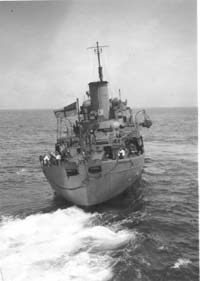 Designed
primarily as a coastal escort, but as a result of operational requirements
(there was nothing else available) the Corvettes ventured into and eventually
right across the Atlantic. The flowers made their name by getting the
strategic convoys from the U.S.A. and Canada through to Great Britain,
while battling not only severe weather conditions but also ever increasing
numbers of German U-boats. Led by a few non-fleet destroyers they will
be associated always with the battle of the Atlantic. They were atrocious
sea keepers, possessing the ability to 'roll on wet grass' but also they
were very seaworthy being able to stay out and hunt for submarines in
storms long after destroyers had turned for home.
Designed
primarily as a coastal escort, but as a result of operational requirements
(there was nothing else available) the Corvettes ventured into and eventually
right across the Atlantic. The flowers made their name by getting the
strategic convoys from the U.S.A. and Canada through to Great Britain,
while battling not only severe weather conditions but also ever increasing
numbers of German U-boats. Led by a few non-fleet destroyers they will
be associated always with the battle of the Atlantic. They were atrocious
sea keepers, possessing the ability to 'roll on wet grass' but also they
were very seaworthy being able to stay out and hunt for submarines in
storms long after destroyers had turned for home.
The health of corvette crews was a concern for all skippers. Living conditions on board any corvette left much to be desired. The continual motion of the ship meant that seasickness was the principal health hazard even amongst the most experienced seamen. The inability to store perishable food for more than two or three days meant the diet of corvette crews consisted mostly of corned beef and powdered everything else, and was consequently poor. Mild forms of scurvy were not unknown. The perpetual dampness of living areas also meant that Tuberculosis began to be diagnosed among longer serving crewmembers.
Life aboard these vessels was both monotonous and stressful. The need for constant vigilance against the enemy, the sea and the cold was of the utmost importance. Sleeping conditions for the ships Officers and Petty Officers were reasonable, but were hard for the seamen in a crowded, stuffy and often water laden mess deck under the forecastle, making living conditions uncomfortable. Sleep was a precious commodity being routinely disrupted by watch changes, bad weather and on good days action stations.
Action, when it came, could be prolonged and brutal the sight, smell and aftermath of a sinking freighter or another warship was something that would always remain with those who witnessed it. Detonating depth charges made a terrible ëhammeringí noise especially in those compartments below the waterline. The torpedoing of a Corvette itself was especially dramatic. As small ships of little more than 1000 tons they only had limited ability to survive battle damage especially of the sort caused by a torpedo or mine. Once hit the compartments below the waterline filled in seconds and caused the ship to sink rapidly. A total of thirty-two 'Flowers' were lost during the war, with twenty-three being sunk by torpedo and four by mines. Of the twenty-three struck by torpedoes thirteen sank in under ten minutes with only five lasting more than an hour.
Information gathered after the war indicates that the Flower Class Corvette was responsible for the sinking of forty-seven U-boats and four Italian submarines. 'Gladiolus' the first of the class to be completed was also the first to participate in the sinking of a U-boat, when together with aircraft she sent U26 to the bottom SSW of Ireland on 1st July 1940.
As the war drew to a close the Flowers where being retired, replaced by the new and improved Castle Class Corvette. After hostilities ended the navy no longer had any need for the Flower Class. Indeed it was the proud owner of many newly completed frigates and destroyers. Many of the Corvettes were worn out after four or five year's constant service in the rough and corrosive North Atlantic. Of the Flowers that survived, 88 were scrapped, 32 sold to foreign navies and 110 sold to commercial companies of different flags. Four became the first British weather ships in 1947, staying in service until being replaced by de-commissioned Castle Class Corvettes between 1958 and 1960. The disposal of the Flowers was so rapid that by 1950 the Navy did not have one that could be used as Compass Rose for the film of Montserrat's book The Cruel Sea. Fortunately the Royal Hellenic Navy was then returning from loan Kreizis, formally commissioned as Coreopsis and she was used for the ship shots before she too was scrapped in the autumn of 1952.
HMCS Sackville is now the only known survivor. Built in 1941 at Saint John in Canada she survived the war and was then converted into a cable laying vessel, then into a loop layer and finally into a survey ship. She has now been fully restored to her wartime guise and is a floating museum at Halifax Nova Scotia.
Many of the Flowers sold to commercial companies where re-sold time and time again. The final fates of these ships will probably never be known, but there was a photo published by Ships Monthly in December of 1993 (and the experts agree) of an aged Flower tied up alongside in Alexandria in 1983. Who knows ???
